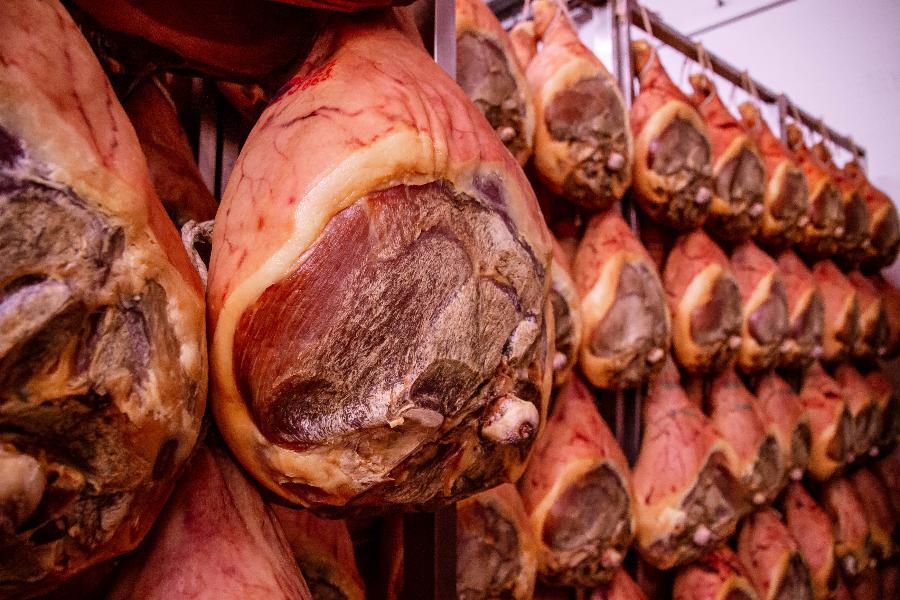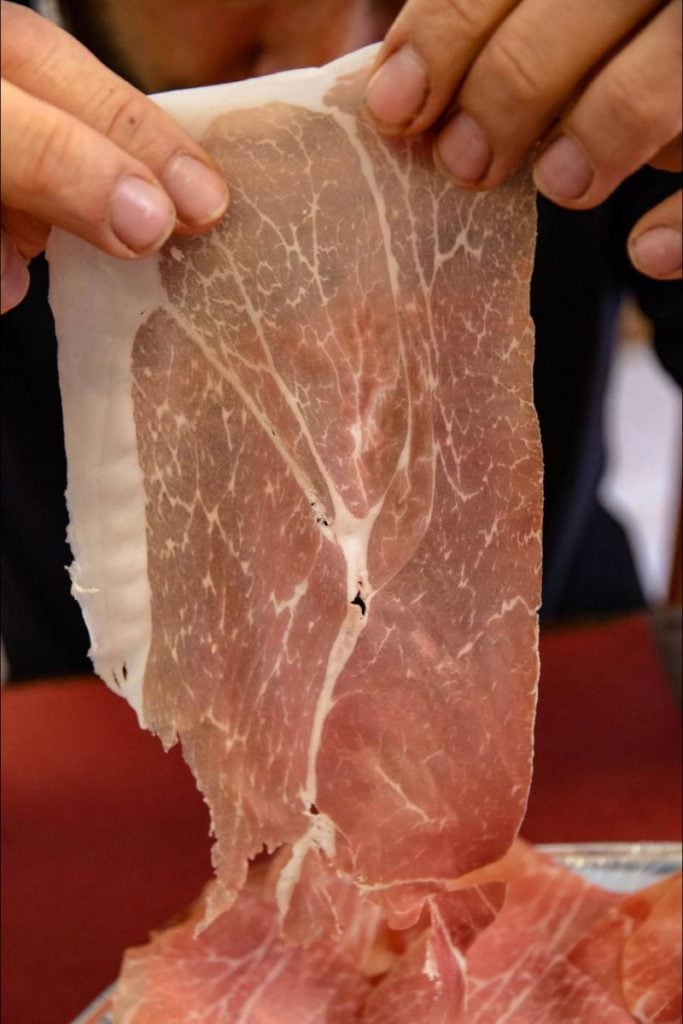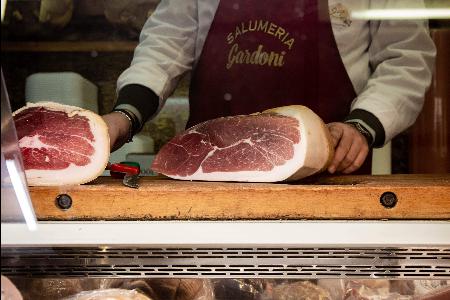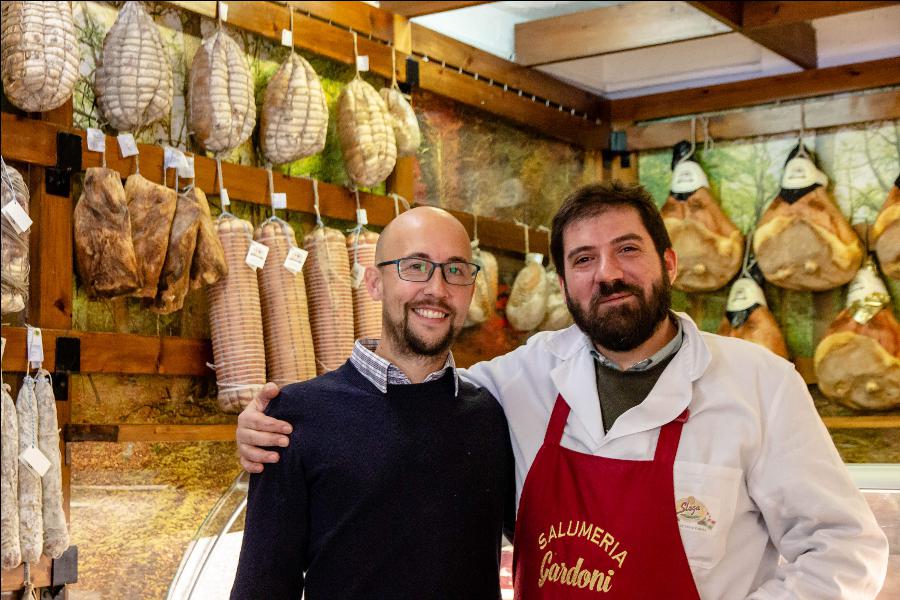Yes, but some versions aren’t raw. The answer depends on the type, many people don’t know that there is a cooked and dry-cured version.
There are hundreds of varieties of prosciutto, but two main types dominate globally: crudo and cotto. Understanding the difference between these two opens up a world of knowledge around Italian meat-curing traditions.
Most prosciutto you’ll find—especially the renowned Parma style—is Prosciutto Crudo. Despite often being called “raw,” it’s been salt-cured and dried over months, sometimes even years.
To me, prosciutto represents the pinnacle of cured meats. My passion for both eating and making it has taken me on long journeys through Italy, from factory tours to countryside tastings that showcased the skill and tradition behind every slice.
Yes, prosciutto can be eaten without cooking—as long as it’s the dry-cured kind like Crudo or Parma Ham. Cotto, on the other hand, is cooked during the production process and doesn’t go through the same curing and drying stages.
Once you begin exploring the depth of this craft, it’s easy to see why prosciutto is so respected. It’s more than food; it’s a legacy of tradition, technique, and time.
Italian production standards, particularly those associated with Protected Designation of Origin (PDO), require a minimum of 12 months of careful curing and drying. This extended process intensifies the flavor and texture—resulting in something that’s truly special.
The pigs used for PDO-certified prosciutto must meet strict quality standards, and the salt-curing process is performed by hand. From the quality of the pork to the region’s microclimate, every detail plays a role in the outcome.


In Italy, Crudo prosciutto is what you’ll typically find. It’s considered “raw” only in the sense that it’s not cooked—but it has undergone a rigorous curing and drying process that makes it perfectly safe to eat.
That process begins with salting, followed by months of controlled drying. Inspections are frequent, especially for products certified under PDO standards. These aren’t quick hams—they’re carefully developed over time.
By contrast, Cotto prosciutto is more like a traditional deli ham. It’s brined, sometimes smoked, and then cooked. It doesn’t go through the same drying phase and isn’t designed for long-term preservation in the same way Crudo is.
Without that moisture reduction and deep flavor development, Cotto is a completely different experience—still tasty, but not what you’d expect if you’re hunting for a true dry-cured delicacy.
Crudo = “Raw”
Cotto = “Cooked”
Why Can It Be Eaten Raw (Dried)
It might feel odd to eat something that looks raw, but prosciutto crudo is anything but. It’s gone through a time-tested process involving salt, time, and airflow that makes it safe and delicious to eat without cooking.
This curing method draws out moisture and creates an environment where harmful bacteria can’t survive. The result is dry-cured meat that’s preserved naturally. If you’re curious about the science behind this, I break it down in my article on how to cure meat for long-term storage.
What many call “raw” is the result of this salt-based transformation. From experience, I’ve found that this drying process does more than preserve—it intensifies flavor and creates a unique texture that’s hard to match.


The Power of Salt in Preserving & Drying
The Ingredients of Prosciutto
At its core, traditional Italian prosciutto—especially under the PDO system—is made from just pork and salt. That’s it. No smoke, no intense processing, just patience and skill.
Of course, not all prosciuttos are created equal. Some producers use nitrates or nitrites to enhance color or extend shelf life, particularly outside the strict PDO regulations. For those interested in how and why these additives are used, I’ve explained more in my nitrate and nitrite summary article.
In practice, quality dry-cured meats also rely on natural mold—like white penicillin—which acts as a protective barrier. It’s the same type you find on dry-cured salami. This is part of what makes dry-curing so special and why it’s safe to eat.
I’ve walked through a prosciutto factory in Parma that produces over 80,000 hams a year—and each one is still salted by hand. That kind of tradition is what makes me respect this craft even more.
There’s often confusion about cured meats in general. People assume they’re the same as processed meats—but that’s not true. If you’re wondering about the differences, I wrote a full post on cured meat vs. processed meat and how they’re fundamentally different.
Dry-curing is slow, deliberate, and relies on time more than anything else. With prosciutto, that time can stretch to 12, 24, or even 36 months. The longer it goes, the more nuanced the flavors become.
I’ve explained more about why this ancient meat preservation method is effective in my full breakdown of what cured meat means and how it’s done.
And if you’re wondering just why this stuff is so prized, I go deep on that in my separate article about why prosciutto is so expensive and special.
Best Ways to Eat Prosciutto
In Italy, the most common way to enjoy prosciutto is also the simplest—just tuck a few thin slices into a quality bread roll. That’s it. No condiments, no garnish. When the meat is this good, you don’t need much else.
Italian food shines through minimalism and quality, and prosciutto is no exception. The saltiness, sweetness, and umami richness of a well-aged slice stands on its own or elevates anything it’s paired with.
One of my favorite combinations is wrapping prosciutto around melon—especially rockmelon. The sweetness of the fruit balances the saltiness of the cured meat, and the fat melts ever so slightly at room temperature. It’s a perfect bite.
I’ve also tried cooking with dry-cured prosciutto, but it’s not my go-to. The heat intensifies the salt and can overpower the dish unless you’re very deliberate. If you do cook it, go light on added salt elsewhere.
Slicing is critical. Wafer-thin slices mellow the salt and let the fat dissolve on your tongue. I’ve tried cutting it thicker just to experiment—and the taste changes dramatically. It becomes chewier, and the salt comes forward hard.
So whenever possible, enjoy it the way it was intended—uncooked, thinly sliced, and savored slowly. You’re not just eating ham; you’re tasting the result of a year (or more) of patience, skill, and tradition.
That’s the real magic of prosciutto—its simplicity hides just how much time and care has gone into it.
How the Salt Cures Prosciutto

Salt curing is ancient—thousands of years old. It works by drawing out moisture, which inhibits bacteria from growing and spoiling the meat. But there’s more to it than just dehydration.
The salt binds within the meat at a cellular level, altering the protein structure slightly and creating an inhospitable environment for spoilage organisms. It also seasons the meat throughout, enhancing flavor as it preserves.
In the case of prosciutto, after salting, the ham rests and begins to lose moisture slowly. Then it goes into drying rooms for months where airflow, humidity, and temperature are carefully managed. Over time, a thin protective mold layer may develop, adding even more depth to the flavor.
It’s a delicate balance of science, tradition, and terroir. And when done right, it transforms a simple leg of pork into one of the finest meats in the world.
Other Aspects of Prosciutto
Thousands of Years of History
Prosciutto isn’t just an iconic food—it’s a product of human survival and ingenuity. Long before refrigeration, the Romans figured out how to use salt and time to preserve pork for months, sometimes years.
During my travels in Italy, I learned that many of these ancient techniques are still in use. The process of breaking down whole pigs into salumi, like prosciutto, was born out of both necessity and a desire to honor every part of the animal.
It’s amazing to think that a slice of prosciutto today shares a common thread with what was being eaten thousands of years ago. That kind of heritage is hard to replicate.
Amino Acids That Are Easier to Digest
One thing that surprised me early on was how prosciutto—and dry-cured meats in general—are often easier to digest than fresh or cooked meat. This comes down to how proteins and amino acids break down over the long curing process.
Drying over time leads to proteolysis, a natural breakdown of protein into smaller components. These become more bioavailable to the body, which means your system has to work less to absorb the nutrients.
I’m not a scientist, but the research supports this. If you’re curious, here’s a useful document published by the Parma Ham Consortium that covers the topic in more depth: Parma Ham: Well-being and Diet (PDF).
Trying the Best Prosciutto
Not all prosciutto is created equal. There are dozens of varieties across Italy and beyond—but some stand out for their quality, aging, and flavor complexity. One of my favorites is Parma Ham aged 24 months or more. It’s subtly sweet, balanced, and melts on the tongue.
Spanish jamón is another world-class option. For something nutty and complex, the jamón ibérico de bellota is exceptional. These pigs are finished on acorns and cured for up to 36 months.
Expert Tip
If you’re buying pre-sliced prosciutto from the supermarket, let it sit at room temperature for 10–15 minutes before eating. Cold fat stays firm and waxy—but once it softens, the texture becomes buttery, and the flavor comes alive.
Can you eat prosciutto straight out of the package?
Yes, if it’s prosciutto crudo (dry-cured), it’s ready to eat straight from the package. It has already been salted, aged, and dried over many months, making it safe and flavorful without cooking.
What is the difference between prosciutto crudo and cotto?
Prosciutto crudo is dry-cured and uncooked, while prosciutto cotto is cooked like a traditional ham. Crudo is aged for months or years, giving it a deeper flavor and firmer texture.
Is prosciutto considered raw meat?
Technically, prosciutto crudo is not raw in the traditional sense. It hasn’t been cooked with heat, but it has been preserved through salt-curing and air drying, which makes it safe to eat.
Can you cook prosciutto crudo?
Yes, but it’s not usually necessary. Prosciutto crudo is best enjoyed uncooked to appreciate its delicate texture and flavor. Cooking it intensifies the saltiness and changes the mouthfeel.
Have a question about prosciutto or dry-curing in general? Drop a comment below—I’d love to help or hear your experience!

Tom Mueller
For decades, immersed in studying, working, learning, and teaching the craft of meat curing, sharing the passion and showcasing the world of charcuterie and smoked meat. Read More
